
by Erik Lovestrand | Jun 30, 2017
Imagine yourself as an early settler, migrating with your family into the area known as La Florida, with the hope of staking a claim and building a new life. You’ve heard stories of horrendous mosquitos, fierce native peoples, deadly snakes, and giant alligators. Regardless, the promise of abundant fish and wildlife, a year-round growing climate and a chance to start anew, override any doubts you might have and you pack your wagon, hitch up your mules and head south with great anticipation.
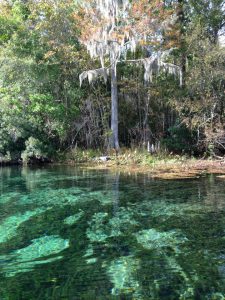
Florida’s springs are world famous. They attracted native Americans and settlers; as well as tourists and locals today.
Photo: Erik Lovestrand
Well, the mosquitos have been horrendous, one of your mules was bitten by a rattlesnake but survived, and one of your hounds was taken by an alligator at a river crossing. You are in your second month of travel and you’ve come into a strange area of forest that stretches for miles in all directions. Deep, white sands clutch at your wagon wheels and make tough going for the mules. The land is forested by tall majestic pines and the terrain is gently rolling with an open view across a landscape dominated by wiry grasses and other low growing herbaceous plants. The buzzing sound of insects in the trees makes it seem even hotter for some reason and everyone is tired and thirsty as you spy a dark line of hardwood trees just down-slope. You decide to take refuge in the shade to rest the lathered mules and hope for a water source to refill your dangerously low water cask.
As you walk back under the shady canopy you find an obvious trail that has been used by other humans for generations as evidenced by a deep rut worn into the ground between exposed limestone boulders. As luck would have it, you see the glint of water through the trees ahead. When you clear the trees near the water’s edge you stop abruptly in stunned amazement. The image of a deep blue pool of crystal clear water with a small stream exiting into the woods causes you to shake your head in disbelief. You must be dreaming, as you’ve never witnessed such a magical setting; water boiling out of a gaping hole in the earth, surrounded by white sand and long flat blades of grass waving in the current.
Just about everyone who has visited one of our sparkling North Florida springs probably has a similar, magical recollection of their first encounter. As surface water percolates downward through soil layers and the porous karst (limestone) bedrock, it is filtered and cleaned to incredible clarity. The clear water gushing forth in these artesian-spring flows remains 69-70 degrees year-round in our Panhandle springs. This is due to their open aquifer connection, from which many homes draw their drinking water directly.
However, there are some serious vulnerabilities that our springs are facing regarding the quality of the water that they provide for residents and visitors alike. One issue relates to the numerous sink holes throughout our landscape that also connect directly to this same Floridan aquifer. In the past, many of these holes have served as dumping grounds for items ranging from household garbage, to junk cars, old washing machines and refrigerators, and even the occasional murder victim. Imagine all of the pollutants that end up in our drinking water supply as a result of this. Another concern relates to pollution that goes onto the ground surface and ends up in the aquifer. This happens via runoff from paved surfaces, sediments and excess fertilizers or pesticides from the landscape, or even the intentional application of treated wastewater in spray fields located in a “spring-shed.” Water clarity and quality at many of our well-known springs has suffered from excess nutrients that cause algal growth and other unwanted, nuisance plant proliferation.
As we gain a better understanding of how water moves through our landscape and ends up flowing from these natural springs, we should become better stewards by minimizing our human impacts that degrade spring water quality. Let’s keep the magic alive for all of our future generations of nature explorers.
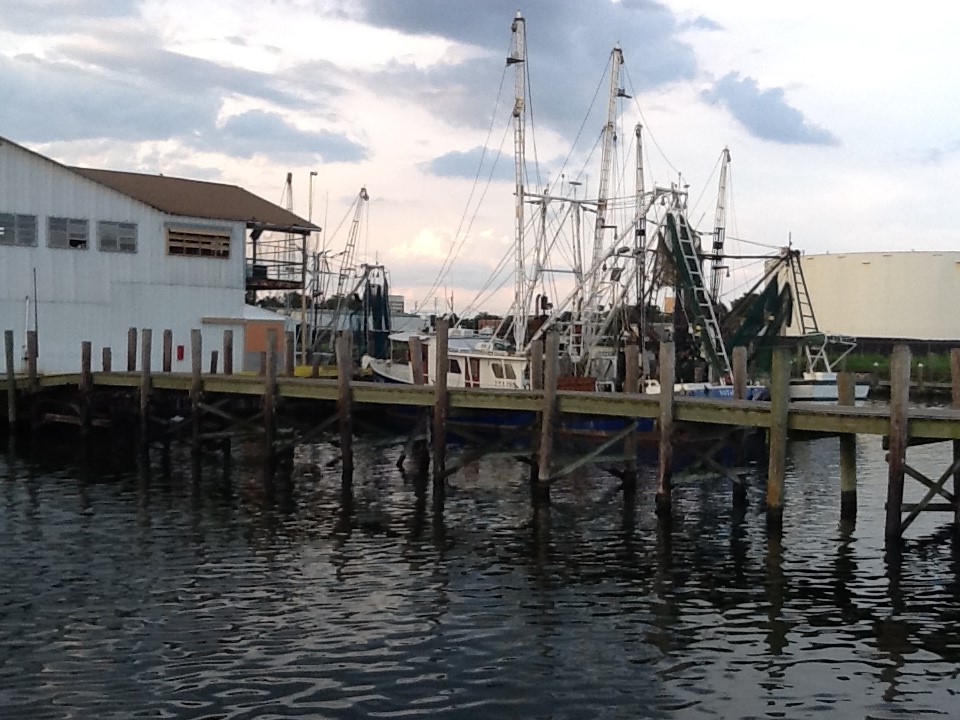
by Rick O'Connor | Jun 17, 2017
ARTICLE WRITTEN BY DR. CHARLES ADAMS, FLORIDA SEA GRANT
The demand for seafood in the US continues to grow. This growth is a function of a number of factors, including the increased awareness of the healthful attributes of many finfish and shellfish products, the increased availability of several key imported, cultured species (shrimp, tilapia, pangasius), and more convenient packaging for home consumption, to name just a few. In terms of wild-caught seafood, effective management at the state and federal level helps ensure the sustainable harvest of traditionally important species, such as reef fish, scallops, flounders, mackerels, and crab.
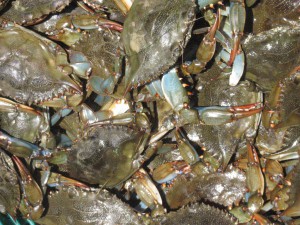
The famous blue crab.
Photo: FWC
According to the latest data from the National Marine Fisheries Service (NMFS), the US domestic fisheries fleet landed about 7.8 billion pounds of edible seafood products, valued at $5.2 billion. Florida plays an important role in this industry, particularly within the Gulf and South Atlantic region. Approximately $250 million worth of seafood is landed by the commercial harvesters in Florida on an annual basis, with some species being landed in Florida, and virtually nowhere else … including pink shrimp, spiny lobster, grouper and stone crab. But wild harvest is not the only source of finfish and shellfish products.
The commercial aquaculture industry is also growing, as the demand for species grown within controlled systems (such as catfish, oysters, striped bass, crawfish, and salmon) continues to increase. The latest NMFS data indicates that the commercial aquaculture industry in the US harvests approximately $1 billion worth of freshwater and saltwater species annually. The success story for aquacultured food items in Florida is molluscan shellfish, in particular cultured hard clams.
Though our wild seafood stocks are sustainably managed and aquaculture production is increasing, approximately 90% of the seafood consumed in the US is imported. Our domestic harvest and culture of seafood simply cannot keep up with demand. We are eating more and more seafood … with the latest NMFS estimate of annual, per capita seafood consumption being 15.5 lbs (edible meat weight). This is the highest level of per capita consumption since 2010. Even though demand is growing, consumers should be confident that the traditional species from our nation’s wild stocks will be there in the future. In addition, the aquaculture industry will help the seafood industry keep pace with growing demand. The seafood industry will continue to be an important source of incomes, jobs, and tax revenue for our coastal communities. And given the increasing number of cultured species and innovative packaging/preparation methods … now is a great time to be a seafood consumer!!
For more information about the US seafood industry, go to https://www.st.nmfs.noaa.gov/Assets/commercial/fus/fus15/documents/FUS2015%20Fact%20Sheet.pdf.
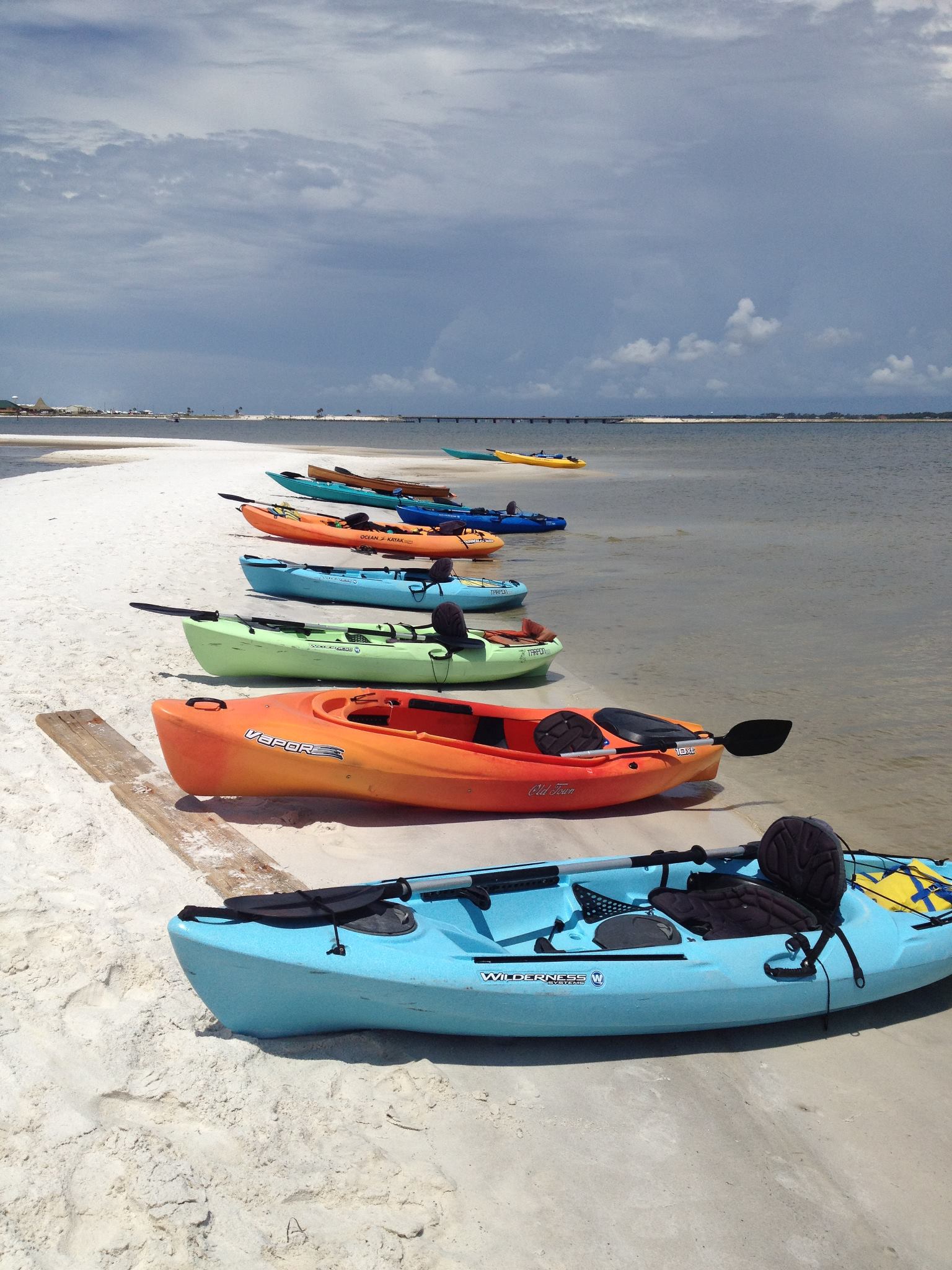
by Carrie Stevenson | Jun 17, 2017
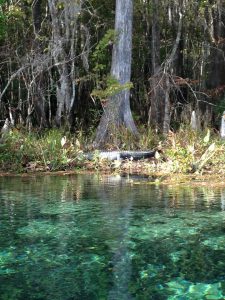
Wakulla Springs is home to some of the best wildlife watching in all of northwest Florida. It’s not unusual to see manatees, alligators, and dozens of species of birds in one boat trip. Photo credit: Carrie Stevenson
What do you imagine when the word “ecotourism” comes to mind? I know I usually daydream about a trip my husband I took to Costa Rica several years ago, surrounded by lush tropical rainforests as we ziplined through the canopy. I might also think about visiting a National Park, following a neatly maintained trail and stopping at signs placed at just the right spot so visitors can read and understand the special features of the place. Ecotourism, done right, brings a visitor to a unique place, tells its story, and immerses the visitor in the sights and sounds in a way that treads lightly on the location. I always know I’ve been on a good ecotour when I’m tired, happy, and have learned or seen something new.
A colleague with The Conservation Fund has stated that sustainable tourism includes: “Authentic experiences that are unique and specialized to the place (its culture, heritage, and natural resources), emphasizes quality over quantity, focuses on distinctive destinations, unspoiled landscapes, and historic buildings, and differs from mass-market tourism by favoring locally-owned businesses, thereby increasing circulation of money in the local economy.” The truly wonderful thing about ecotourism is that local touch; it exists solely because of the place, so it cannot be outsourced. The best storytellers about those places are usually the people who have lived there for many years, so by its very nature, ecotourism provides jobs for local residents.
Northwest Florida has hundreds of unique locations for visitors and locals to explore…we have centuries-old forts, clear-blue springs, endless rivers and creeks to paddle, trails on the coast and up our modest hills. We have caves and underground caverns, waterfalls, pitcher plant prairies, fishing, wildlife watching, and reefs for snorkeling and SCUBA diving. While millions come here for our quartz-sand beaches, other options that highlight our natural ecosystems deserve more attention and notoriety.
A few years ago, several Extension Agents received funding for a project called Naturally EscaRosa. The idea behind that project was to help promote and create businesses that sustainably used our agricultural and natural resources. The website (www.naturallyescarosa.com) has a list of over 100 businesses and locations where locals and out-of-town visitors can explore the less well-traveled areas of Escambia and Santa Rosa County. As you move east down the coast, Walton Outdoors, the local Visit Florida affiliates, and other privately managed media groups have done similar work, providing a showcase for these treasures in our midst.
This summer, try one of the local ecotourism or agritourism venues near you! Moreover, when your friends and family visit from out of town, encourage them to do the same. We cannot have a successful economy without a healthy ecosystem, and supporting these local and regional businesses is good for both.
For more information on sustainable ecotourism, visit the Society for Ethical Ecotourism (SEE), and for information on starting or visiting an agritourism business, try Visit Florida Farms. And as always, reach out to your local County Extension agents, and we will be more than happy to point you in the right direction to discover to places to explore with your family.
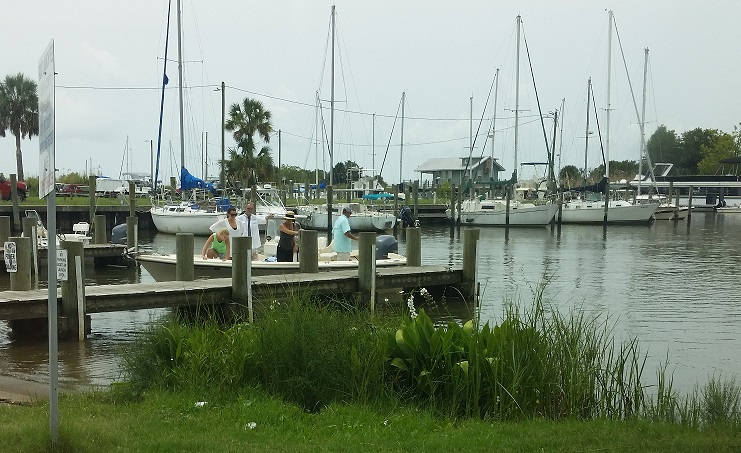
by Erik Lovestrand | Jun 3, 2017
Anticipation of the catch is what thousands of Panhandle boaters will have on their minds as they leave the docks this summer for a day of fishing. However, a hasty departure in their excitement to get to that favorite spot may be the recipe for an outing some would prefer to forget; or worse, a tragedy that could have been prevented.
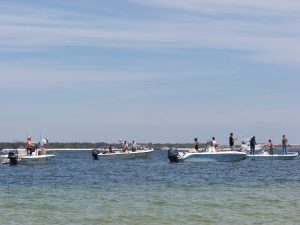
Inshore fishing near Pensacola Pass
Photo: Molly O’Connor
Here are a few things to consider when planning a day on the water that will greatly increase your odds of having success in what matters most; a fun day and safe return for all. Heck, you can always make up some fish stories.
Equipment Check: A basic safety check involves many key aspects that can make or break a trip.
Trailer: (current tag, tires, lights, tie downs, safety chain and winch condition)
Boat: (current registration, navigation gear, vhf radio, motor condition, fuel/oil check, navigation lights, battery, anchor and rope, boat plugs, paddles)
Safety equipment: (flares, fire extinguisher, personal flotation, emergency locator beacon, sound producing device)
Tools: (basic kit with vice grips, needle nose pliers, wire cutters, screw drivers, adjustable wrench, etc.)
Miscellaneous: (sun screen, food, hat, rain gear, polarized glasses, drinking water, cell phone, dry bag, first-aid kit, medicine)
Fishing gear and bait, of course! (Insert garage full of “stuff” here)
Refer to this Fish and Wildlife Conservation Commission (FWC) LINK to know the legal requirements for safety gear on the size vessel you will be using. These vary depending on the length and design of the hull. In addition, the FWC provides information on the Boating Safety Education Course that is a requirement for anyone born on or after January 1, 1988; and a good idea for us “more mature” folks too.
Even if you are not taking to the water in a powerboat, many of the same common-sense and legal requirements apply to personal watercraft, kayaks and canoes. This FWC LINK provides the requirements for class-A recreational vessels less than 16 feet in length and canoes and kayaks.
In addition to all of the “stuff” you’ll need for a good day, you should also have knowledge of the waters that you will be boating on. Appropriate navigational charts are important but first-hand knowledge is always the best. If you are not familiar with the area you are boating on, at least talk to someone you know who has been in that area. It wouldn’t be a bad idea to take along this friend, who would probably enjoy a day on the water too.
When you think about it, there really is a lot of stuff to keep up with when you are going out on the water as the responsible party. But the last thing you want to do is skimp on the safety aspects of your planned adventure. You would be better off to have left your favorite rod in the garage, next to your lucky hat.

by Laura Tiu | Jun 3, 2017
There are five species of sea turtles that nest from May through October on Florida beaches. The loggerhead, the green turtle and the leatherback all nest regularly in the Panhandle, with the loggerhead being the most frequent visitor. Two other species, the hawksbill and Kemp’s Ridley nest infrequently. All five species are listed as either threatened or endangered under the Endangered Species Act.
Due to their threatened and endangered status, the Fish and Wildlife Conservation Commission/Fish and Wildlife Research Institute monitors sea turtle nesting activity on an annual basis. They conduct surveys using a network of permit holders specially trained to collect this type of information. Managers then use the results to identify important nesting sites, provide enhanced protection and minimize the impacts of human activities.
Statewide, approximately 215 beaches are surveyed annually, representing about 825 miles. From 2011 to 2015, an average of 106,625 sea turtle nests (all species combined) were recorded annually on these monitored beaches. This is not a true reflection of all of the sea turtle nests each year in Florida, as it doesn’t cover every beach, but it gives a good indication of nesting trends and distribution of species.
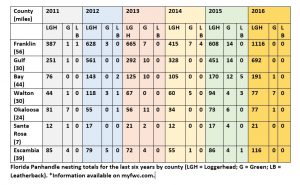 If you want to see a sea turtle in the Florida Panhandle, please visit one of the state-permitted captive sea turtle facilities listed below, admission fees may be charged. Please call the number listed for more information.
If you want to see a sea turtle in the Florida Panhandle, please visit one of the state-permitted captive sea turtle facilities listed below, admission fees may be charged. Please call the number listed for more information.
- Gulf Specimen Marine Laboratory, 222 Clark Dr, Panacea, FL 32346 850-984-5297 Admission Fee
- Gulf World Marine Park, 15412 Front Beach Rd, Panama City, FL 32413 850-234-5271 Admission Fee
- Gulfarium Marine Adventure Park, 1010 Miracle Strip Parkway SE, Fort Walton Beach, FL 32548 850-243-9046 or 800-247-8575 Admission Fee
- Navarre Beach Sea Turtle Center, 8740 Gulf Blvd, Navarre, FL 32566 850-499-6774
To watch a female loggerhead turtle nest on the beach, please join a permitted public turtle watch. During sea turtle nesting season, The Emerald Coast CVB/Okaloosa County Tourist Development Council offers Nighttime Educational Beach Walks. The walks are part of an effort to protect the sea turtle populations along the Emerald Coast, increase ecotourism in the area and provide additional family-friendly activities. For more information or to sign up, please email ECTurtleWatch@gmail.com. An event page may also be found on the Emerald Coast CVB’s Facebook page: facebook.com/FloridasEmeraldCoast.










